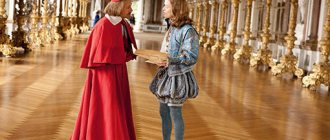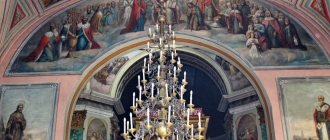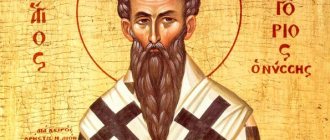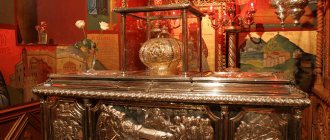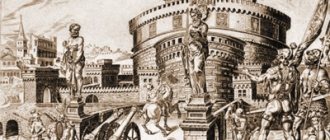GREGORY III
Gregory III, Pope of Rome. Engraving. 1600 (Saachi. Vitis pontificum. 1626) (RSL)
Gregory III, Pope of Rome. Engraving. 1600 (Saachi. Vitis pontificum. 1626) (RSL) († 28.11.741), St. (memorial dated December 10), Pope (from March 18, 731). According to the Liber Pontificalis, Syrian by birth; in the Verona catalog of popes (late 8th century) he is called a Roman. Before being elected pope, he served as a presbyter in Rome. c. St. Chrysogon. In Liber Pontificalis, as well as in Rome. Canon Flodoard indicates that G. was elected to the Papal See of Rome. by the people after the death of Pope Gregory II and approved 35 days later by the Exarch of Ravenna (representative of the Byzantine Emperor in Italy).
Having taken the Roman See, G. continued the fight against iconoclasm, which became part of the social and church policy of the Byzantine Empire. Recognizing Byzantium. Emperor as the highest secular ruler, G. sent the Rev. to K-pol. George, in order to notify the emperors Leo III the Isaurian and Constantine V Copronymus of his election and convey a written admonition against iconoclasm. Fearing the anger of the emperors, the papal ambassador did not do this, for which, upon returning to Rome, G. wanted to deprive him of his dignity, but by decision of the Roman Council (spring 731) he sentenced him only to public repentance. Soon the pope again sent Rev. George in K-pol with a message against iconoclasm, which became known in the capital of Byzantium, and George was detained by the emperor. officials on the island of Sicily.
1 Nov 731 G. convened a new Council in Rome, which declared anathema to anyone who desecrates or blasphemes icons and sacred images. According to the epitome of the Cassinian Chronicle, attributed to Anastasius the Librarian (9th century), the same Council demanded that the inhabitants of the bishoprics of Aurelian (modern Orleans, France) and Cenoman (modern Le Mans, France) return to the Cassinian monastery (modern . Monte Cassino) relics of St. Benedict of Nursia and his sister St. The scholastics, who during the period of desolation of the monastery (from the end of the 6th to the beginning of the 8th century) were transferred to Gaul by the monks of Fleury Abbey. To notify the emperors about the decisions of the Council, the pope sent the defensor Constantine to K-pol with a message demanding the restoration of icon veneration; from Italian Patrick Sergius sent bishops with the same demands, but both ambassadors were detained on the island of Sicily and imprisoned. In 732/3, G. sent the defensor Peter to the emperors and to the K-Polish Patriarch Anastasius (information about the mission has not been preserved).
In Rome, the pope was actively involved in the repair and construction of churches, founded at the Cathedral of St. Peter's oratory and crypt ap. Andrew, 6 porphyrite columns were installed in the cathedral, donated by the Exarch of Ravenna Eutychius, on which gilded images of the Savior and the Virgin Mary were placed. Under G. the c. were partially rebuilt. Rev. Virgin Mary "ad Presepe" (now the church of Santa Maria Maggiore), c. Rev. Virgin Mary "ad Martires" (ancient Pantheon), Basilica of St. Pavla, c. martyr Genesia, c. St. Mark on the Appian Way, c. Rev. Virgin Mary "in Aquiro" and others, the monastery of St. was restored. Pankratiya, a monastery was established at Ts. St. Chrysogon beyond the Tiber, in which G. served as a presbyter, a church was built. ap. Peter at the catacombs of Petronilla and c. Saints Peter and Marcellinus near Lateran. All these churches, by order of the pope, were richly decorated with icons, crosses and other sacred images.
In 734, imp. Leo III organized a naval expedition to Rome with the goal of overthrowing G. and capturing the city, but the flotilla he sent was destroyed by a storm. Unable to organize a new expedition, the emperor ordered the confiscation of the land holdings of the Roman Church in Sicily, Apulia and Calabria; Epistoms in the Balkans, previously under the jurisdiction of Rome, were subordinated to the Polish Patriarchate. Being in complete political isolation in Italy, G. turned out to be the independent ruler of the former. Byzantine Roman ducat, having at its disposal only part of the army of the Ravenna Exarchate. In the beginning. 30s the pope intervened in the armed conflict between the Lombard cor. Liutprandom and Hertz. Spoletia (modern Spoleto) by Thrasamund, having managed to stop the war for a while. The period of relative peace gave Greece the opportunity to begin restoring the cities and fortresses destroyed by the Lombards; By his order, the walls of the city of Centumzella (modern Civitavecchia) were restored.
In 739, G.'s relationship with the cor. Liutprand escalated sharply due to the pope's support for Hertz. Thrasamund, who tried to get out of submission to the Lombard king. G. refused to hand over the rebellious duke, who had fled to Rome, to Liutprand; at the same time, the conflict was complicated by the alliance concluded by the pope with Liutprand’s opponent Hertz, who came to power in Benevento (modern Benevento) (738). Godeskalk II (Gotschalk). In Aug. 739 Liutprand set out on a campaign against Rome. Not wanting to ask for help from the iconoclast emperor, G. turned to the Franks for support. Majordomo Charles Martell (740), thereby marking the beginning of the development of relations with the rulers of the Franks. In an effort to help the pope, Charles Martell sent abbots Grimon and Sigibert on a diplomatic mission to Liutprand, who achieved the lifting of the siege of Rome. However, Liutprand continued to hold 4 fortresses in the Roman Ducat, which G. could not be returned, despite the mediation of the bishops of Tuscia (modern Tuscany). G.'s repeated request for help, sent to Charles Martell, remained without a specific answer (741). In 741, the pope entered into an alliance with Thrasamund, agreeing with the help of Rome. troops liberate Spoletium in exchange for the duke's military support in returning those captured to Rome. fortresses. On Dec. 741 Rome the army occupied Spoletium and, having expelled Liutprand's henchmen, restored the power of Thrasamund. However, the duke, breaking his promises, did not provide support to the Romans.
Following the example of his predecessor, G. continued to promote the spread of Christianity in Germany: he ordained Vavila as Bishop of Patavia (modern Passau) and elevated St. to the rank of Archbishop. Boniface, who preached in Thuringia and East Saxony. In 737, Boniface arrived in Rome, where G. endowed him with the powers of a legate, confirming his primacy among the bishops of Bavaria and Alemannia and granting him the right to establish new episcopal sees in these lands. In 740, G. approved the archbishop. Boniface reorganized the church administration. structure in Bavaria, which consisted in dividing the country into 4 dioceses and appointing bishops for them. To help Boniface, the pope sent St. Willibald (Vita prima S. Willibadi. 36).
According to the main text of Liber Pontificalis, G. died on November 28. 741, which contradicts the indication of the title of his biography, according to which the pope occupied the department for 10 years, 8 months and 22 days, i.e. until December 10. 741. According to L. Duchesne, the latter date is more likely, since the biography of G.'s successor, Pope Zacharias, says that the Romans took Spoletium during G.'s lifetime, i.e. in the beginning. Dec. 741 Buried in the oratory at the Cathedral of St. Petra.
The Liber Pontificalis notes G.'s education and knowledge of Greek. and lat. languages, eloquence. The pope is described as an ascetic, his concern for the poor, widows and orphans, and the ransom of captives is emphasized. Mention of the celebration of the memory of G. first appears in certain manuscripts of the Martyrology of the Bishop of Vienne. St. Adon (IX century) on November 28; the same date was preserved in the Roman Martyrology until 1922, when G.’s memory was moved to December 10.
Works: PL. 89. Col. 557-598; MGH. Epp. T. 3. P. 290-293, 703-708.
Source: Mansi. T. 12. Col. 271-301; L.P. Vol. 1. N 415-425; Flodoardus Remensis. De Chricti triumphis apud Italiam. 11, 5 // PL. 135. Col. 793-798; Paul. Diac. Hist. Langobard. 6. 55-58 // PL. 95. Col. 661-668; Fredegarius scolasticus. Cronicum. Pars 3, 90 // PL. 71. Col. 680; Willibaldus. Vita S. Bonifatii. 24-27, 30 // PL. 89. Col. 621-622, 624-625; Othlonus. Vita S. Bonifatii. I. 26, 28-32 // PL. 89. Col. 647-649; Vita prima S. Willibaldi. 34-35 // ActaSS. Jul. T. 2. P. 509-510; Ado Vienensis. Martyrologium: Append. //PL. 123. Col. 433.MartRom. P. 553; Theoph. Chron. S. 410.
Lit.: Hefele Ch.-J. A History of the Councils of the Church. Edinb., 1896. Vol. 5. P. 301-304; Mesnard M. La basilique de St. Chrysogone à Rome. Vat., 1935; Bertolini O. Roma di fronte a Bisanzio e ai Longobardi. Bologna, 1941. P. 453-477; Rabikauskas P. Gregorio III // BiblSS. Vol. 7. Col. 290-294; Lanne E. Rome et les images saintes // Irénikon. 1986. Vol. 59. P. 170-171; Borodin O. R. Ravenna Exarchate. Byzantines in Italy. St. Petersburg, 2001. pp. 116-117.
D. V. Zaitsev
Notes
- [www2.fiu.edu/~mirandas/bios726.htm The Cardinals of the Holy Roman Church]. Retrieved March 15, 2013.
- Mann, p. 204
- Levillain, p. 643
- Treadgold, p. 354; Mann, p. 205
- Levillain, p. 644; Mann, p. 206
- Duffy, p. 64; Mann, p. 207
- Mann, p. 208
- Mann, pp. 208-209
- Duffy, p. 63; Mann, p. 210
- Mann, pp. 210-211
- Mann, pp. 211-212
- Mann, pp. 212-213
- Levillain, p. 644
- Mann, pp. 214-215
- Schwabe Calvin W.
Unmentionable Cuisine. - Charlottesville: University of Virginia Press, 1979. - P. 157. - ISBN 0813908116. - Mann, p. 216
- Mann, p. 221
- Mann, pp. 216-217
- Treadgold, p. 355; Mann, pp. 217-218
- Duffy, p. 68
- Mann, pp. 219-220
- Mann, p. 220
- Levillain, p. 644; Mann, p. 222
- Levillain; p. 644; Mann, pp. 221-222
- Mann, p. 223
Iconoclasm[edit]
Immediately after his accession, Gregory turned to Emperor Leo III with a request to soften his position regarding iconoclasm. When Gregory's representative was arrested by order of the emperor, Gregory convened a synod in November 731, which categorically condemned iconoclasm. [5] Leo responded by attempting to bring the pope under control, but the fleet he sent to carry out the imperial will was shipwrecked in the Adriatic Sea. [6] He then proceeded to the corresponding papal territories in Sicily and Calabria, and transferred ecclesiastical jurisdiction in the former praetorian prefecture of Illyria to the Patriarch of Constantinople. [7] However, his attempt to force the Duke of Naples to comply with the imperial decree confiscating papal territory in the duchy failed because the duke supported the pope's position. [8]
Gregory, meanwhile, demonstrated his opposition to iconoclasm by emphasizing his veneration of icons and relics. He repaired or decorated numerous churches, decorating them with icons and images of Jesus Christ, the Virgin Mary and saints. the iconostasis in the center
, located between six onyx and marble columns that were sent to Gregory as a gift from the exarch Eutyches. [10] He built a new oratory in St. Peter's Basilica to house the relics of a number of saints, calling a synod in 732 to regulate the prayers and masses to be said there. [11] Gregory was an ardent supporter of monasticism; he founded the monastery of Saint Chrysogonus and rebuilt the shelter of Saints Sergius and Bacchus near Saint Peter's Basilica, donating it to support the poor. [12]
Nadezhda Meikher: “We were all a little jealous of him”
“I remember him for some incredibly acute sense of justice,” singer Nadezhda Meikher, who twice participated in the “Dancing with the Stars” project, tells us. “And even if he criticized someone on the floor, it was all very dignified and delicate. Always to the point, fair. And if he did praise, he did it with such inspiration that wings grew on you. All of us who knew him treated him with enthusiasm and deep respect. And you know, even a little with white envy: at his age he was incredibly energetic. To preserve the vitality of both body and spirit in such a way - I have never met such people. His thirst for life was simply unquenchable.
Alena Shoptenko: “He is an example of how to work and live”
“I know, now I already knew, Grigory Nikolaevich is quite good, because we taught at the same department at the Kiev University of Culture,” choreographer Alena Shoptenko tells us. “He is a master of his craft and has always been an example for me of how to work and live in general.” We communicated very well. He was open, not afraid of experiments, and willingly accepted everything new. His speeches to students were always very profound, and it was clear that teaching brought him pleasure. In the first “Dances...” he sympathized with our couple with Vladimir Zelensky. I remember his words: “Pair number five showed themselves, as always, well.”
Early years and expansion of missionary activity[edit]
Almost immediately, Gregory began repairing the Aurelian walls in Rome, starting with the Porta Tiburtina. [5] Work on this task was delayed in October 716 when the Tiber River overflowed its banks and flooded Rome, causing massive damage and taking only eight days to recede. [5] Gregory ordered a series of litanies to stop the flood, which spread to the Campus Martius and the so-called Plains of Nero, reaching the foot of the Capitoline Hill. [8] In the first year of his pontificate a letter arrived from Patriarch John VI of Constantinople, who tried to justify his support for Monothelitism, while at the same time seeking papal sympathy for the position he was in vis-à-vis the emperor. Gregory responded by sending a letter outlining the traditional Roman position against monothelitism. [9]
Then, in 716, Gregory paid an official visit to Duke Theodo of Bavaria to discuss the ongoing conversion of his lands to Christianity. As a result of this meeting, Gregory gave specific instructions to his delegates, who were to travel to Bavaria, coordinate with the Duke, and establish a local church hierarchy under the supervision of an archbishop. [10] Gregory maintained an interest in Bavaria; in 726 he forced the unwilling Corbinian, after considering his appeal through a synod, to renounce his monastic calling and become bishop of Freising in Upper Bavaria. [eleven]
Gregory then turned his attention to Germany. In 718, he was approached by the Anglo-Saxon missionary, Winfried, who proposed carrying out missionary work in Germany. [12] Gregory agreed and, after changing his name to Boniface, assigned him to preach in Germany in May 719. [1] Upon learning of the work done, Gregory summoned Boniface back to Rome in 722 to answer rumors about the purity of Boniface's doctrine. [13] At this private meeting, Boniface complained that he found Gregory's Latin difficult to understand, a clear sign that Vulgar Latin had already begun to turn into Romance languages. [14] After studying Boniface's written confession of faith, Gregory was sufficiently satisfied that that he made Boniface bishop in November 722 and returned him to Germany to continue his mission. [1] Continued success led Gregory to write to Boniface in December 724 to express his congratulations, followed by a response to Boniface's questions in November 726 about how to structure new churches in Germany. [15]
Gregory also strengthened papal authority in the churches of Britain and Ireland. In 726, Gregory was visited by Ina, the former king of Wessex, who had abdicated the throne to make a pilgrimage to Rome and end his life there. [16]
Literature
- Gregory, Roman popes // Encyclopedic Dictionary of Brockhaus and Efron: in 86 volumes (82 volumes and 4 additional). - St. Petersburg, 1890-1907.
- Gregory (Roman popes) // Small encyclopedic dictionary of Brockhaus and Efron: in 4 volumes - St. Petersburg, 1907-1909.
- Levillain, Philippe (2002). The papacy: Gaius-Proxies. New York: Routledge. ISBN 9780415922302.
- Duffy, Eamon (2006). Saints & Sinners: A History of the Popes. New Haven, Conn.: Yale University Press. ISBN 9780300115970.
- Treadgold, Warren (1997). A History of the Byzantine State and Society. Stanford, California: Stanford University Press. ISBN 0804726302.
- Mann, Horace K. (1914). The Lives of the Popes in the Early Middle Ages. Vol. I: The Popes Under the Lombard Rule, Part 2, 657-795. pp. 203–224.
| 2nd century | Alexander I • Sixtus I • Telesphorus • Hyginus • Pius I • Anicetus • Soter • Eleutherius • Victor I • Zephyrinus |
| III century | Calixtus I • Urban I • Pontian • Anter • Fabian • Cornelius • Lucius I • Stephen I • Sixtus II • Dionysius • Felix I • Eutyches • Gaius • Marcellinus |
| IV century | Marcellus I • Eusebius • Miltiades • Sylvester I • Marcus • Julius I • Liberius • Damasius I • Siricius • Anastasius I |
| 5th century | Innocent I • Zosimus • Boniface I • Celestine I • Sixtus III • Leo I • Gilarius • Simplicius • Felix III (II) • Gelasius I • Anastasius II • Symmachus |
| 6th century | Hormizd • John I • Felix IV (III) • Boniface II • John II • Agapitus I • Silverius • Vigilius • Pelagius I • John III • Benedict I • Pelagius II • Gregory I |
| 7th century | Sabinian • Boniface III • Boniface IV • Adeodates I • Boniface V • Honorius I • Severinus • John IV • Theodore I • Martin I • Eugenius I • Vitaly • Adeodates II • Domnus • Agathon • Leo II • Benedict II • John V • Conon • Sergius I |
| 8th century | John VI • John VII • Sisinnius • Constantine • Gregory II • Gregory III • Zachary • Stephen II • Stephen II (III) • Paul I • Stephen III (IV) • Adrian I • Leo III |
| 9th century | Stephen IV (V) • Paschal I • Eugene II • Valentine • Gregory IV • Sergius II • Leo IV • Benedict III • Nicholas I • Adrian II • John VIII • Marinus I • Adrian III • Stephen V (VI) • Formosus • Boniface VI • Stephen VI (VII) • Romanus • Theodore II • John IX • Benedict IV |
| 10th century | Leo V • Sergius III • Anastasius III • Landon • John X • Leo VI • Stephen VII (VIII) • John XI • Leo VII • Stephen VIII (IX) • Marinus II • Agapitus II • John XII • Leo VIII • Benedict V • John XIII • Benedict VI • Benedict VII • John XIV • John XV • Gregory V • Sylvester II |
| 11th century | John XVII • John XVIII • Sergius IV • Benedict VIII • John XIX • Benedict IX • Sylvester III • Benedict IX • Gregory VI • Clement II • Benedict IX • Damasus II • Leo IX • Victor II • Stephen IX (X) • Nicholas II • Alexander II • Gregory VII • Victor III • Urban II • Paschal II |
| 12th century | Gelasius II • Calixtus II • Honorius II • Innocent II • Celestine II • Lucius II • Eugenius III • Anastasius IV • Hadrian IV • Alexander III • Lucius III • Urban III • Gregory VIII • Clement III • Celestine III • Innocent III |
| XIII century | Honorius III • Gregory IX • Celestine IV • Innocent IV • Alexander IV • Urban IV • Clement IV • Gregory X • Innocent V • Adrian V • John XXI • Nicholas III • Martin IV • Honorius IV • Nicholas IV • Celestine V • Boniface VIII |
| XIV century | Benedict XI • Clement V • John XXII • Benedict XII • Clement VI • Innocent VI • Urban V • Gregory XI • Urban VI • Boniface IX |
| 15th century | Innocent VII • Gregory XII • Martin V • Eugene IV • Nicholas V • Calixtus III • Pius II • Paul II • Sixtus IV • Innocent VIII • Alexander VI |
| 16th century | Pius III • Julius II • Leo X • Adrian VI • Clement VII • Paul III • Julius III • Marcellus II • Paul IV • Pius IV • Pius V • Gregory XIII • Sixtus V • Urban VII • Gregory XIV • Innocent IX • Clement VIII |
| 17th century | Leo XI • Paul V • Gregory XV • Urban VIII • Innocent X • Alexander VII • Clement IX • Clement X • Innocent XI • Alexander VIII • Innocent XII • Clement XI |
| XVIII century | Innocent XIII • Benedict XIII • Clement XII • Benedict XIV • Clement XIII • Clement XIV • Pius VI • Pius VII |
| 19th century | Leo XII • Pius VIII • Gregory XVI • Pius IX • Leo XIII |
| XX century | Pius X • Benedict XV • Pius XI • Pius XII • John XXIII • Paul VI • John Paul I • John Paul II |
| XXI Century | Benedict XVI • Francis |
| The list is divided by century based on the start date of the pontificate | |
Life after deposition
Gratiano, no longer Gregory VI, was sent to Germany at the disposal of Bishop Hermann of Cologne [3] and died the following year (1047). Meanwhile, the new Pope Clement II died in the same year, but some time before Gregory. When Clement died, many (including the Bishop of Liege) asked Henry to restore Gratiano, since they considered his abdication illegitimate. Henry refused, and Gratiano died soon after, ending the debate.[3] Henry supported Poppo Brixen, who became Pope Damasius II.
Early life[edit]
Gregory was born in 669 into a noble Roman family [2]. He was the son of Marcellus and Hesta. [3] Gregory II was the purported ancestor of the Roman family of Savelli, [4] according to a 15th-century chronicler, but this is unattested in modern documents and is very likely unreliable. The same was said of Pope Benedict II in the seventh century, but nothing definite is known about the relationship between the two.
As a young man, he was placed in the papal court, and was made subdeacon and sacellarius of the Roman See during the pontificate of Sergius I (687 - 701). He later became a deacon and was in charge of the Vatican Library. [5] During Constantine's pontificate, Gregory was made papal secretary, and accompanied the pope to Constantinople in 711 to resolve issues raised by Rome's refusal of canons in the Council of Quinisext. [6]The actual negotiations on the controversial articles were led by Gregory, with the result that Emperor Justinian II agreed that the papacy could ignore any decision of the council it wished. [7]
After Constantine's death on April 9, 715, Gregory was elected pope and was consecrated Bishop of Rome on May 19, 715.[5]
Pontificate
At the beginning of the reign of Gregory VIII, news of the defeat of the crusaders at Hattin (July 4, 1187) reached Europe. The Pope, seeing the danger to Jerusalem (in fact, at this point the city had already been taken by Saladin on October 2, but this was not yet known), called for the Third Crusade in his bull of October 29, 1187 "Audita tremendi". For the sake of the future campaign, Gregory VIII reconciled with Frederick Barbarossa and Heinrich Hohenstaufen. Since a fleet was needed to transport the crusaders, Gregory VIII personally went to Pisa to achieve reconciliation between the Pisan Republic and another maritime republic, Genoa. On December 17, 1187, Gregory VIII died after less than two months of pontificate and was buried in the Pisa Cathedral.
